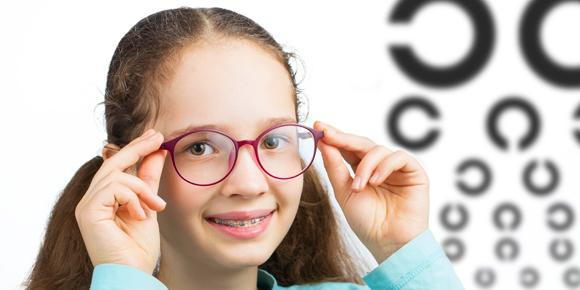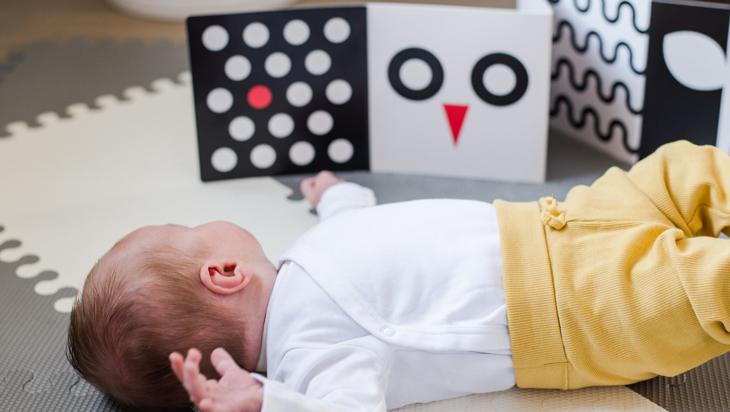- Home >
- Recognizing Vision Problems in Your Child
Recognizing Vision Problems in Your Child

According to the Centers for Disease Control and Prevention, 6.8 percent of American children suffer from some kind of vision problem.
As a concerned parent, you need to know what normal vision skill acquisition looks like from birth onward, how to recognize the telltale signs of visual impairment, what those signs might indicate in terms of underlying conditions, and how to stay on top of whatever diagnosis and treatment your child may need. Let's examine the world of pediatric vision issues.
Normal Stages of Pediatric Visual Development

Don't expect your newborn infant to gaze at you, or anyone else, with clear eyesight. Vision is a skill that must be learned, with the eyes and the vision center of the brain developing the necessary eye muscle coordination, visual interpretive skills, and other abilities that combine to create proper eyesight as we know it. Here are the stages of visual development and the outward signs you want to look for.
First month
During the first month of life, your baby should be reacting to bright lights and faces or objects held at close range. Crossed eyes are common before the eye muscles learn how to coordinate with each other.
Second and third months
Your baby can now follow lights, faces, and objects with its eyes. Tear production should be evident at this stage.
Months four through seven
During this stage, babies notice their images in mirrors, reach for objects that their eyes fixate on, and develop both color vision and specific color preferences.
By 18 months
Babies will typically see well enough to play peek-a-boo, crawl toward objects in their field of vision, track fast-moving things, recognize familiar toys, and other items.
By 36 months
Three-year-olds have usually developed the ability to accommodate both near and distance vision easily. They can use their refined visual skills to draw pictures, identify parts of the body, and build hand-to-eye coordination.
Preschool years
Ideally, a preschooler's vision should come close to 20/20, with the ability to focus at extremely close range and recognize letters or shapes.
School years
During the school years, a child with normal vision can read, write, see a blackboard, and make full use of depth perception.
Common Causes and Symptoms of Vision Problems in Kids

Vision problems can appear at any stage of life, including any of the stages listed above. Some vision problems and eye disorders are obvious at birth, while others take time to make themselves known to parents and eye care doctors.
For instance, if your baby is born with cataracts, those cataracts may appear as milky-white discolorations. A refractive error such as nearsightedness or farsightedness, however, may go undetected until the child is old enough to undergo vision testing and communicate with the vision therapist. Common pediatric eye problems and their symptoms include:
Strabismus
This eye alignment occurs when the eye muscles are uneven in length or haven't developed the expected degree of coordination. One or both eyes may seem to turn either inward or outward.
Amblyopia
In this disorder, also called lazy eye, the brain's vision center depends largely on one eye's input while ignoring that of the other eye. It may occur if one eye has a refractive error, strabismus, or other impairment. Kids with amblyopia may struggle with depth perception and physical coordination.
Ptosis
Ptosis is a drooping eyelid that partly blocks incoming light, potentially limiting visual development in the affected eye. It can be a factor in amblyopia.
Glaucoma
Children can sometimes develop this disease, in which high pressure inside the eye damages the optic nerve. Look for watery eyes, light sensitivity, eyelid spasms, cloudy-looking corneas, and bulging eyes.
Conjunctivitis
Also known as pink eye, conjunctivitis is an inflammation/infection of the clear membrane that covers the sclera of the eye. Viruses, bacteria, allergens, and other irritants can cause conjunctivitis.
Refractive errors
Refractive errors such as farsightedness and nearsightedness represent one of the most common visual challenges in kids. If your child has trouble reading classroom materials clearly (struggling in school as a result) and shows signs of fatigue such as eye rubbing or irritation, suspect a refractive error.
How to Monitor and Address Vision Issues in Your Child
Eye diseases and disorders early in life can seriously stunt your child's long-term visual skills and development. That's why you need to schedule several key eye and vision exams for your child throughout the growing years.
A very basic eye exam on your newborn to look for obvious structural problems such as cataracts or retinal issues. Your eye care specialist should administer the first comprehensive vision exam around the age of six months. This exam, while also fairly basic, can reveal a baby's ability to focus on and track moving objects or lights.
Schedule a second major eye exam for your child during the "toddler years" (two to three). This exam can analyze your child's rate of visual development while also making the first efforts to check for refractive errors.
The third major exam, administered just before your child enters school, will go into even more depth, including the use of a standard eye chart to determine whether your child needs corrective lenses before embarking on the demands of school life.
Your eye doctor can provide you with a full recommended eye exam schedule, providing treatment for primary diseases and disorders or referring you to a specialist for advanced conditions.
Looking after your little ones' health is easier than you might assume once you know what problems to look for and how to schedule the appropriate care.

According to the Centers for Disease Control and Prevention, 6.8 percent of American children suffer from some kind of vision problem.
As a concerned parent, you need to know what normal vision skill acquisition looks like from birth onward, how to recognize the telltale signs of visual impairment, what those signs might indicate in terms of underlying conditions, and how to stay on top of whatever diagnosis and treatment your child may need. Let's examine the world of pediatric vision issues.
Normal Stages of Pediatric Visual Development

Don't expect your newborn infant to gaze at you, or anyone else, with clear eyesight. Vision is a skill that must be learned, with the eyes and the vision center of the brain developing the necessary eye muscle coordination, visual interpretive skills, and other abilities that combine to create proper eyesight as we know it. Here are the stages of visual development and the outward signs you want to look for.
First month
During the first month of life, your baby should be reacting to bright lights and faces or objects held at close range. Crossed eyes are common before the eye muscles learn how to coordinate with each other.
Second and third months
Your baby can now follow lights, faces, and objects with its eyes. Tear production should be evident at this stage.
Months four through seven
During this stage, babies notice their images in mirrors, reach for objects that their eyes fixate on, and develop both color vision and specific color preferences.
By 18 months
Babies will typically see well enough to play peek-a-boo, crawl toward objects in their field of vision, track fast-moving things, recognize familiar toys, and other items.
By 36 months
Three-year-olds have usually developed the ability to accommodate both near and distance vision easily. They can use their refined visual skills to draw pictures, identify parts of the body, and build hand-to-eye coordination.
Preschool years
Ideally, a preschooler's vision should come close to 20/20, with the ability to focus at extremely close range and recognize letters or shapes.
School years
During the school years, a child with normal vision can read, write, see a blackboard, and make full use of depth perception.
Common Causes and Symptoms of Vision Problems in Kids

Vision problems can appear at any stage of life, including any of the stages listed above. Some vision problems and eye disorders are obvious at birth, while others take time to make themselves known to parents and eye care doctors.
For instance, if your baby is born with cataracts, those cataracts may appear as milky-white discolorations. A refractive error such as nearsightedness or farsightedness, however, may go undetected until the child is old enough to undergo vision testing and communicate with the vision therapist. Common pediatric eye problems and their symptoms include:
Strabismus
This eye alignment occurs when the eye muscles are uneven in length or haven't developed the expected degree of coordination. One or both eyes may seem to turn either inward or outward.
Amblyopia
In this disorder, also called lazy eye, the brain's vision center depends largely on one eye's input while ignoring that of the other eye. It may occur if one eye has a refractive error, strabismus, or other impairment. Kids with amblyopia may struggle with depth perception and physical coordination.
Ptosis
Ptosis is a drooping eyelid that partly blocks incoming light, potentially limiting visual development in the affected eye. It can be a factor in amblyopia.
Glaucoma
Children can sometimes develop this disease, in which high pressure inside the eye damages the optic nerve. Look for watery eyes, light sensitivity, eyelid spasms, cloudy-looking corneas, and bulging eyes.
Conjunctivitis
Also known as pink eye, conjunctivitis is an inflammation/infection of the clear membrane that covers the sclera of the eye. Viruses, bacteria, allergens, and other irritants can cause conjunctivitis.
Refractive errors
Refractive errors such as farsightedness and nearsightedness represent one of the most common visual challenges in kids. If your child has trouble reading classroom materials clearly (struggling in school as a result) and shows signs of fatigue such as eye rubbing or irritation, suspect a refractive error.
How to Monitor and Address Vision Issues in Your Child
Eye diseases and disorders early in life can seriously stunt your child's long-term visual skills and development. That's why you need to schedule several key eye and vision exams for your child throughout the growing years.
A very basic eye exam on your newborn to look for obvious structural problems such as cataracts or retinal issues. Your eye care specialist should administer the first comprehensive vision exam around the age of six months. This exam, while also fairly basic, can reveal a baby's ability to focus on and track moving objects or lights.
Schedule a second major eye exam for your child during the "toddler years" (two to three). This exam can analyze your child's rate of visual development while also making the first efforts to check for refractive errors.
The third major exam, administered just before your child enters school, will go into even more depth, including the use of a standard eye chart to determine whether your child needs corrective lenses before embarking on the demands of school life.
Your eye doctor can provide you with a full recommended eye exam schedule, providing treatment for primary diseases and disorders or referring you to a specialist for advanced conditions.
Looking after your little ones' health is easier than you might assume once you know what problems to look for and how to schedule the appropriate care.
Contact Us
Thank you. Your submission has been sent.

